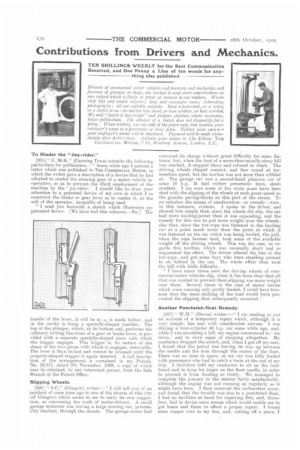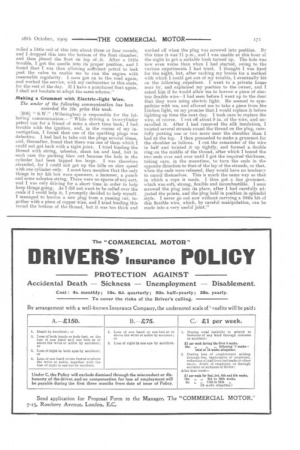Contributions from Drivers and Mechanics.
Page 20

Page 21

If you've noticed an error in this article please click here to report it so we can fix it.
TEN SHILLINGS WEEKLY for the Best Communication Received, and One Penny a Line of ten words for any thing else published,
Drivers of commercial motor vehicles and tractors, and nrechanic and foremen of garages or shops, are invited to send short contributions on any subject which is likely to prove of interest to our readers. Workshop tips and smart repairs; long and successful runs ; interesting photogray hs : all are suitable subjects. Send a post.card, or a letter, or a sketch to us—no mater how short, or how written, or how worded. We will " knock it into shape" and prepare sketches, where necessary, before publication. The absence of a sketch does not disqualify for a
prize. Vhen writing use one side of the perper only and mention your employer's name as a guarantee of brma fides. Neither your own m r your employer's name will be disclosed. Paymcnt will be made immediately after publ.r.tum. Address your letters to I he Editor, Tus COMMERCIAL Moron, 7 15, Rolehery Avenue, Londtm, E.C.
To Hinder the "Joy-rider."
[6051 ' S. McK." (Canning Town) submits the following particulars for publication.—" Some while ago I noticed a letter which was published in THE COMMERCIAL MOTOR, in which the writer gave a description of a device that he had 'adopted to render the steering gear of a motor vehicle inoperative, so as to prevent the illicit employment of the machine by the ' joy-rider.' I should like to draw your attention to a patented device of my own in which I so construct the brake or gear lever as to render it, at the will of the operator, incapable of being used. " I send you herewith a sketch which illustrates my patented device. [We have had this redrawn.—En.] The
handle of the lever, it will be s is made hollow, and
in the cavity is hung a specially-shaped tumbler. The top of the plunger, which, at its bottom end, performs the ordinary locking functions of a gear or brake lever, is provided with a separate specially-shaped piece with which the trigger engages. This trigger is, by nature of the shape of the two pieces with which it engages, removable. The lever is then lot ked and cannot be released until the properly-shaped trigger is again inserted. A full description of the arrangement is contained in my Patent, No. 23,971, dated 9th November, 1908, a copy of which may be obtained, by any interested person, from the Sale Branch of the Patent Office.
Slipping Wheels.
[606j " S.C." (Glasgow) writes :—" I will tell you of an incident of some time ago in one of the streets of this city (of Glasgow) which seems to me to carry its own suggestion, as concerning the work of motor-drivers. A small garage motorcar was towing a large touring car, presumably disabled, through the streets. The garage motor had conveyed its charge without great difficulty for some distance, but, when the foot of a more-than-usually-steep hill was reached, it stopped there and refused to climb. The driving wheels slipped contact, and flew round at tremendous speed, but the towline was not more than nibbled at. The garage car was a second-hand pleasure car of sonic 16 h.p. It had rubber pneumatic tires, steelstudded. I am sure some of the studs must have been shed with the slipping of the wheels at such great speed on the granite paving-blocks at this part of the street. To an onlooker the means of amelioration—or remedy—were. in this instance, evident.. I spoke to the driver, and showed him simply that, since the wheels did slip, the car had more hauling-power than it was expending, and the remedy for this was to put more weight over the wheels ; also that, since the tow-rope was fastened to the hauling car at a point much lower than the point at which it was fastened on the car which was being hauled, the pull, when the rope became taut, took some of the available weight off the driving wheels. This was the case, as regards this towline, which was unusually short and so augmented the effect. The driver altered the line of the tow-rope, and got some boys who were standing around to sit behind in the car. The whole affair then took the hill with little difficulty.
" I have many. times seen the driving wheels of commercial-motor vehicles slip, when it has been clear that all that was wanted to prevent their slipping was more weight over them. Several times in the case of motor lorries whiell were running only partly loaded, I could have foreseen that the mere shifting of the load would have prevented the slipping that subsequently occurred."
Another Punctured-float Remedy.
_607] " W.H." (Devon) writes :—" I am sending to you an account of a temporary repair which, although it is very simple, has met with considerable success. I was driving a four-cylinder :30 h.p. car some while ago, and, while I was ascending a hill, my engine commenced to ' die down,' and to show signs of stopping altogether. My conductor dropped the scotch, and, when I got off my seat, I found that the petrol was forcing its way up between the needle and the hale through the centre of the float. There was no time to spare, as my ear was fully loaded with passengers who had to catch a. train at the end of my trip. I therefore told my conductor to sit on the footboard and to keep his finger on the float needle, in order to prevent it from flooding so freely. We managed to complete the journey to the station fairly satisfactorily, although the engine was not running as regularly as it, might have been. I then removed the carburetter cover, and found that the trouble was due to a punctured float. I had no facilities at hand for repairing this, and, therefore, bad to devise some means which would enable me to get home and there to effect a proper repair. T found some copper wire in my box, and, cutting off a piece, I rolled a little coil of this into about three or four rounds, and I dropped this into the bottom of the float chamber, and then placed the float on top of. it. After a little trouble, I. got the needle into its proper position, and I found that I was then allowing sufficient petrol to leak past the valve to enable me to run the engine with reasonable regularity. I soon got on to the road again, and worked the service, with my carburetter in this state, for the rest of the day. If I have a punctured float again, I shall not hesitate to adopt the same scheme."
Making a Grummet with Electric-light Wire.
The sender of the following communication has been awarded the 10s. prize this week.
r_608] " SM." (Wilmington) is responsible for the following communication.—" While driving a two-cylinder _petrol van for a friend of mine a short time back, I had trouble with the ignition, and, in the course of my investigation, I found that one of the sparking plugs was defective. I had had to take out the plugs several times, and, thereafter, found that there was one of them which I could not get back with a tight joint. I tried binding the thread with string, asbestos, sheet tin and lead, but in each case the packing blew out because the hole in the cylinder had been tapped too large. I was therefore stranded, for I could not get up the hills on slow speed with one cylinder only. I must here mention that the only things in my kit box were spanners, a hammer, a punch -and some asbestos string. There were no spares of any sort, and I was only driving for a short time in order to help keep things going. As I did not want to be called over the coals if I could help it, I promptly decided to help myself. managed to borrow a new plug from a passing car, together with a piece of copper wire, and I tried binding this round the bottom of the thread, hut it was teo thick and worked off when the plug was screwed into position. By this time it was 11 p.m., and I was unable at this hour of the night to get a suitable bush turned up. The hole was now even worse than when I had started, owing to the various experiments I had tried. I thought I was fixed for the night, but, after racking my brains for a method with which I could get out of my trouble, I eventually hit on the following expedient. I went to a private house near by, and explained my position to the owner, and I asked him if he would allow me to borrow a. piece of electric flexible wire-1 had seen before I went up to the door that they were using electric light. He seemed to sympathize with me, and allowed me to take a piece from the kitchen light, on my promise that I would replace it before lighting-up time the next day. I took care to replace the wire, of course. I cut off about 9 in. of the wire, and unravelled it. After I had removed the silk insulation, I twisted several strands round the thread on the plug, carefully putting one or two more near the shoulder than I had at the top. I then proceeded to make a grummet for the shoulder as follows. I cut the remainder of the wire in half and twisted it up tightly, and formed a double ring on the middle of the thread, after which I bound the two ends over and over until I got the required thickness, taking care, in the meantime, to turn the ends in the opposite direction to that of the lay of the strands, so that, when the ends were released, they would have no tendency to uncoil themselves. This is much the same way as that in which a rope is made. I thus got a fine grummet, which was soft, strong, flexible and incombustible. I soon screwed the plug into its place, after I had carefully adjusted the points, and the plug held in position in splendid style. I never go out now without carrying a little bit of this flexible wire, which, by careful manipulation, can be made into a very useful joint."






















